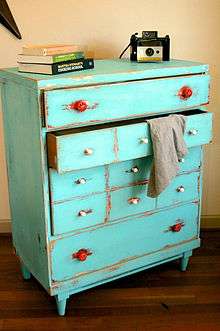Shabby chic
Shabby chic (/ˈʃæb.iˈʃiːk/) is a form of interior design where furniture and furnishings are either chosen for their appearance of age and signs of wear and tear or where new items are distressed to achieve the appearance of an antique. At the same time, a soft, opulent, yet cottage-style decor, often with an affected feel is emphasized to differentiate it from genuine period decor.
Description
Shabby chic items are often heavily painted through the years, with many layers showing through obviously time-worn areas. The style is imitated in faux painting using glaze or by painting then rubbing and sanding away the top coat to show the wood or base coats, known as "distressing" the finish of the furniture. Furniture pieces that are not genuine antiques are usually selected for their resemblance to older furniture styles, and may be reproduction furniture with a distressed finish. Elaborate furniture appliques depicting flower swags and garlands, cherubs, and other motifs may be added.
Fabrics tend to be cottons and linens, with linen being particularly popular, inspired by old French linens. Pure whites, as well as ecrus and worn or bleached out pastel colors are favorites. Fabric is often stained with tea to give it the look of old fabric. Bleached and faded are terms often applied to the style. Vintage floral patterns with pastel colors, cotton ticking patterns, or linen in earth tones, are all typical of shabby chic style.
Antique pieces such as pie safes and jelly cupboards are popular in shabby chic décor.[1] Besides white, the shabby chic style also includes soft neutral colors such as sky blue, rose pink and beige tones. Hints from French-style interior design often show in shabby chic homes such as Rococo-style lighting fixtures, furniture or wall paneling.
The shabby chic aesthetic also expands to the garden, with the same design principles of using timeworn garden furniture and feminine accessories. Rose gardens are popular with the shabby chic style of decor.
Other popular decor items are pillows made of vintage barkcloth fabric, vintage linens, chenille bedspreads, vintage chandeliers, and anything with roses in the design. It is a soft, relaxed, feminine, romantic style of decorating that looks comfortable and inviting.
Variants of shabby chic style include:
- Cottage chic
- Beach cottage chic
- French country
- Gustavian (Swedish)
History

The style started in Great Britain and evokes the type of decoration found in large country houses where there are worn and faded old chintz sofas and curtains, old paintwork and unassuming 'good' taste. The end result of shabby chic is to achieve an elegant overall effect, as opposed to the sentimentally cute Pop-Victorian. Recycling old furniture and fabrics is an important aspect of the look and was especially popular with modern Bohemians and artisans that made up a sidelined counter-culture movement during the 1980s when expensive quality decor became very fashionable with the upper middle classes. The original shabby chic interiors were usually considered in themselves works of art.
The early forms of shabby chic were rather grand but the style has evolved taking inspiration from many forms of decoration. These range from 18th century Swedish painted decoration, the French Chateau as well as the American Shakers where simplicity and plainness was essential.
Origin of term
The term was coined by The World of Interiors magazine in the 1980s[2] and became extremely popular in the US in the '90s with a certain eclectic surge of decorating styles with paints and effects, notably in metropolitan cultural centres on the West Coast of America, such as Los Angeles and San Francisco, with heavy influences from Mediterranean cultures such as Provence, Tuscany and Greece.
See also
References
| Wikimedia Commons has media related to Shabby chic. |
- ↑ "Shabby Chic Decorating". Source. Retrieved 25 December 2014.
- ↑ Coad, Jenny (11 July 2014). "Threadbare carpets, grubby walls, creaky floors? Don't fret - the shabby chic look has never been more fashionable". MailOnline.